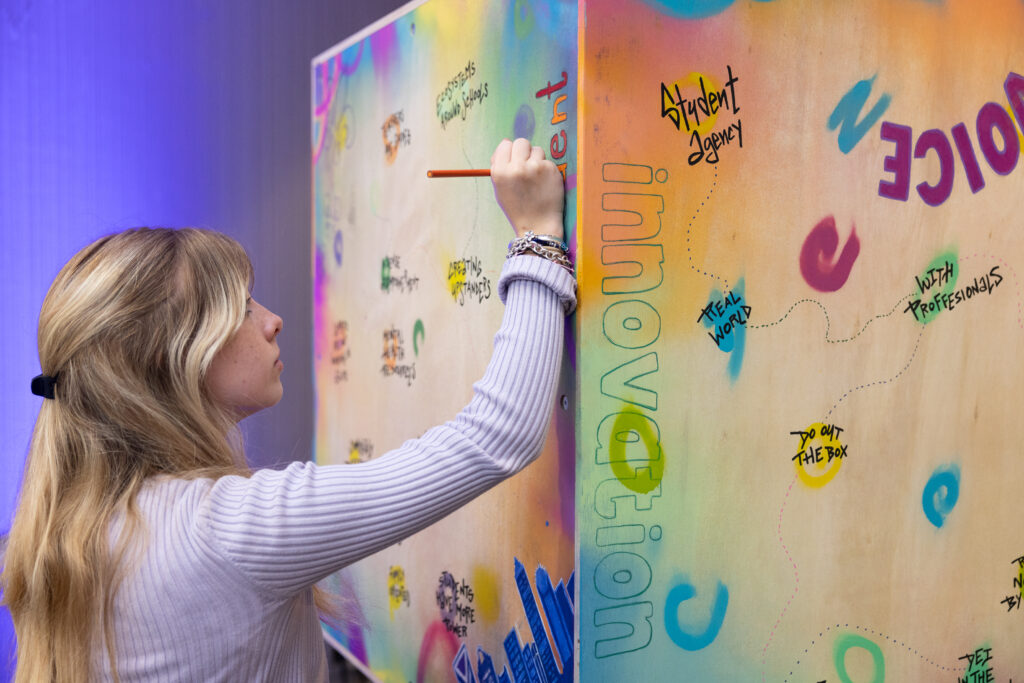Entrepreneurs Looking For a Real Challenge Find It – At School
Like a lot of entrepreneurs, Michael Milkie has big dreams. Like the innovators at Yahoo and Microsoft who’ve revolutionized information technology and software development, Milkie, too, would like to take a huge industry in a completely new direction. But there’s a big difference: Milkie is a former public school teacher and co-founder of the Noble Network of Charter Schools in Chicago. He wants to revamp the way kids – particularly those in the toughest neighborhoods with the worst-performing schools – are educated.
Milkie opened his first high school in 1999 on the near west side of Chicago, taking advantage of the then-new concept of charter schools, free public schools that can design their own curricula and operations as long as they deliver high performance. Already, that high school is scoring near the very top citywide on state achievement tests, and it has a 1,000-student waiting list. He plans to open seven more schools over the next three years, hoping to build a critical mass of Noble students to inspire other Chicago public schools to perform.
“Right now we have 500 students, and when they’re all open we should have 3,500” he says. “At that point we’ll be about 10 percent of the high school population in Chicago, and that percentage alone puts a lot of competitive pressure on the [public school] system to improve, and it keeps pressure on us to keep those seats filled.
While not as rich and famous as the founders of many technology companies, education entrepreneurs like Milkie share something besides ambition with their Silicon Valley counterparts: money and support from venture capitalists. Perhaps the best known backer of education entrepreneurs looking to transform the schools available to low-income, primarily minority students is the San Francisco-based NewSchools Venture Fund, a nonprofit philanthropy launched in 1998. One of the founders is John Doerr, a legendarily prescient venture capitalist who was an early backer of companies like Google, Amazon, and Sun Microsystems. Another of NewSchools’ financial supporters? The Bill & Melinda Gates Foundation.
A Different Approach
Not surprisingly, Doerr and NewSchools’ take on education reform is radically different from that aired in most school board meetings and legislative sessions. They aim, essentially, to utilize the venture capital model: Find and support innovative educators, and then let the benefits of their experimentation filter back into the wider school system. The only difference from a regular VC deal is that these funds are seeking improved student performance and opportunity rather than profits. “The idea of supporting entrepreneurs is a slightly different theory of change,” says Ted Mitchell, president and CEO of the NewSchools Venture Fund. “It says, rather than going into the system and supporting new programs, let’s support new ideas outside of the system but encourage them to have an impact on the system.”
Obviously, the VC approach can only succeed with the leadership of extremely skilled, creative educators. NewSchools, which has granted about $75 million since its launch, is meticulous in evaluating applicants, typically taking about six months to ask questions and investigate. Because the fund focuses on changing inner-city public education – a colossal task indeed – it generally looks for schoolmasters who have grand plans. Typically, the successful grant applicants want to launch more than just one school. But size can’t come at the expense of top-notch education, Mitchell cautions. “Scale is important to us, but scale is not a substitute for quality,” he says.
Once the fund finds its innovators, it remains deeply involved with those education entrepreneurs for several years, just as venture capitalists are with the for-profit companies they choose. NewSchools’ funding commitment usually lasts three to five years, and the fund always takes a seat on the board that oversees the charter-management organization. The fund also provides management guidance and acts as a resource for problem-solving. But like any good venture capitalist, NewSchools also expects results. When schools don’t hit student performance and enrollment benchmarks, funds can be withheld. And by the time NewSchools steps out of the funding, its schools are expected to function solely on the money governments pay for their students’ education, with assistance from local philanthropy.
A Compelling Challenge
That a bunch of Silicon Valley venture capitalists would imagine they can drastically improve the quality of public education in inner-city America is not all that surprising: VCs are well-known for their big ambitions, confidence, and egos. But a fair question might be, why bother? Unlike other investments, there’s no monetary return to supporting education entrepreneurs. In fact, for people like Doerr, who donated millions to help establish the NewSchools Venture Fund, it’s a big financial loss. Besides, teachers’ unions and many politicians are hostile, sometimes vociferously so, to the very idea of charter schools.
But the stakes are clearly very high. With U.S. schools’ too-high dropout rate and depressingly low science and math test scores, the ability of American businesses to find skilled, competitive employees is very much in doubt. On an even more elemental level, Mitchell points out, there’s just something wrong with a system that allows so many students to attend schools that prepare them for, well, nothing. “The moral commitment really starts with the injustice that is perpetrated every day in lots of struggling urban school districts that deprive kids of their opportunity to succeed, their opportunity to fulfill their dreams, and their opportunity to participate in the civic life of the country,” he says.
In some of the places where NewSchools has invested, that’s changing. New, even unorthodox, approaches are reaping rewards. At Mastery Charter Schools in Philadelphia , students don’t pass a course unless they score at least a 76, which is considered “mastery” level; in most public schools, 70 is a passing grade. Students at the two Mastery high schools – where most are African-American and low-income – also can’t graduate unless they complete a half-year internship and at least one college-level course.
To Scott Gordon, the CEO of Mastery Charter Schools, these seemingly high standards – which keep fully 20 percent of the student body in high school for a fifth year – are simply ways to ensure that kids are ready for success in the world. “If they’ve passed an internship for half a year, then we feel pretty good that they can survive and compete in the global economy, that they’ve learned what the workplace is like,” Gordon says. “If they can take a college level course, we feel like we’ve done our job. They’re ready for college.” And indeed, many Mastery students continue their education after high school; nearly 80 percent of the class of 2005 went on to a four-year college or university.
At Lighthouse Academies – which operates schools in the Bronx; Washington, D.C.; and the Midwest – the arts are infused into the classroom as much as possible. “Our theory is that arts integrated into core academics is very engaging to children, and higher levels of engagement can lead to higher levels of achievement,” says Lighthouse president and CEO Mike Ronan, who cites UCLA research that supports his approach. So, when teachers are presenting a lesson on, say, percentages, they’ll have students use colored construction paper to make bar charts representing 10 percent, 20 percent, and so forth. “Because more of my senses had been engaged, I’d be more interested,” Ronan says. “I’d retain it and I’d be more participatory.”
Clearly, then, there’s no one static model for the mode of education NewSchools Venture Fund will support. In fact, that’s exactly the approach it’s trying to avoid. As Mitchell sees it, public education hamstrings itself to the belief that there’s just one model that works. “Sometimes we are critiqued for a lack of focus,” Mitchell says. “We think that our unique role is to be supporting entrepreneurs who are really at the high-risk end of things.”
It’s a role that Mitchell, who left his job as president of California’s Occidental College to join NewSchools full time, clearly relishes. “It’s an extraordinary privilege to be able to work with these folks, and if we can provide them material and intellectual resources, then so much the better,” he says. “But they’re the ones who are doing the real work out there, and that’s how I judge the success of NewSchools.”


